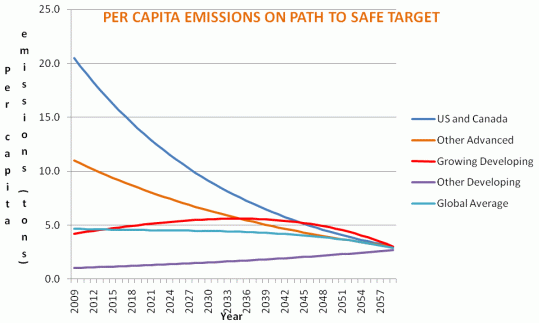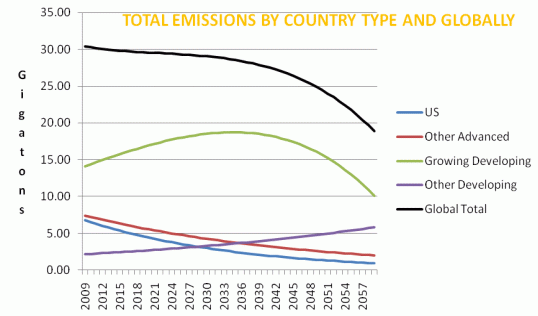The climate change debate is extraordinarily complex because the issue is. Most agree that there remains considerable uncertainty about long-term temperature shifts.
- Some claim it is not a demonstrated problem.
- The majority at this point are convinced there is a significant fat-tailed risk down the road (time horizon on the order of 50 to 75 years) and that we should “buy” insurance by planning to reduce carbon emissions now. The questions are how much and who pays.
- Still others believe the time horizons are shorter and that adaptation rather than mitigation should be the central focus.
The attention devoted to adaptation is entirely justified. There is a different but important tail risk here. In addition, mitigation and adaptation are connected. Adaptation options and costs are crucial inputs to proper mitigation benefit calculations. But for this column, I focus on mitigation.
Basic carbon facts
On the mitigation/insurance strategy, the world is trying to figure out by how much emissions should come down, on what time path, who should do it, and how the costs should be absorbed. What exactly should be the practical content of respecting principle of “common but differentiated responsibilities,” embodied in the United Nations Framework?
The developing countries are an increasingly important part of the picture because of their growth. In the future, they will be a dominant influence. Currently, developing country per capita emissions are low but their populations are large. Their aggregate emissions are high and rising.
Global emissions are now about 31 billion tons of CO2 per year, about twice the IPCC safe level. Of that total:
- 21% is North America (with per capita output of 20 tons);
- 23% is the rest of the advanced countries (with per capita emissions of 11 tons), and
- The remaining 46% is the developing world with 5.4 billion people.
- Developing world per capita output is just over 3 tons per person; the corresponding figure for advanced countries is close to 14 tons per person.
These differences are important. Energy consumption and carbon emissions increase with income.
The high-growth developing world challenge
The high-growth part of the developing world accounts for about 3.4 billion people. On a 50 year time horizon, they will achieve or come close to advanced country income levels with consumption, energy use, and emissions patterns to match. Added to the current advanced country population of 1 billion, there will be on the order of 4.4 billion people (out of a global population of 6.5 billion) with energy use and emissions patterns like the US, Europe, and Japan.
Without a global mitigation strategy and even if the high-growth developing countries hit the current “European” per capita emission levels (as opposed to the higher North American ones), global emissions will almost double over 50 years to about 58 billion tons a year; per capita emissions will go from the current 4.8 tons to about 8.7 tons per person. Almost all of the increment is associated with developing country growth. This path would be extraordinarily risky and is unlikely to be the path we take.
Delayed growth: An ugly stalemate
If developing countries were to agree to cap their emissions at current levels or even some other relatively low number, their growth would be negligible or delayed by several decades while the technology to make possible the achievement of advanced country incomes with much lower energy consumption and carbon emissions is developed. Going down this path is likely to result in an ugly stalemate with delayed progress, and the real risk of the negative fallout for the openness of the global economy.1 Even if advanced countries absorb most of the mitigation costs in developing countries, energy consumption and emissions will rise for some time. That does not mean that the game is lost, but rather that it will take time and persistence to get there.
So we have two broad sets of forces at work globally.
- Growth in countries (with over 3 billion people) that are still relatively poor will raise energy consumption and emissions.
- Incentives, the rising marginal cost of energy augmented by the declining cost of alternatives, technology and public policy to support the latter, and aggressive advanced country programs to reduce the carbon intensity of their economies will alter the technological base and reduce the carbon intensity of economies at all levels of per capita income (first in the advanced countries and with a lag in the developing world).
In the short run, the first will dominate.
On a 50 year time horizon, a substantial fraction of the high growth developing world will have graduated to advanced country status. At that point whenever it occurs, they will need to line up with the then prevailing norms for advanced countries. In addition, anticipating that transition, developing countries will be absorbing the energy- and carbon-reducing technology on the way. That will not impede their growth, but it will slow the rate of increase of their emissions. What impedes (and creates risk to) growth is capping emissions now with current technology.
A reasonable depiction of the time path of per capita and global emissions is shown in Figures 1 and 2.
Figure 1. Per capita emission on path to safe target
Figure 2. Total emissions
All this is intertemporally complex. And the numbers are daunting. Currently in the advanced countries, a ton of CO2 emissions is the by-product of generating 2000 to 3000 dollars of income. To get into the neighbourhood of the safe level globally of 2.3 tons per person, that inverted carbon intensity number of 2-3 thousand, has to go to around 11,000 dollars of income per ton of CO2. It is a huge change.
Advanced countries have to get there first
There is an important point of agreement that serves as a guide to creating a viable framework. It is that the advanced countries have to get there or no one else will be able to do so. They will have the lead in technology. For a considerable period of time, they will also have higher emissions per capita, but the emissions will be coming down. The developing countries will experience rising energy consumption and carbon emissions and start to catch up. But in the coming decades, they will absorb (and help develop) technology that will dampen their emissions growth and eventually decrease emissions as they line up with the advanced countries and approach that status themselves.
Something like this pattern will accommodate developing country growth and has a reasonable chance of approaching the long-run global emissions targets.
What are the key ingredients in a recipe that gets us there?
We are at the start of a long process and don’t know how things will evolve four and five decades out, with respect to population, technology, and other factors. There will be many iterations. Persistence will have a high payoff, and we will learn much as we go along. The challenge now is to head in the right direction with a viable framework and not get hung up arguing about the precision of estimates five decades from now. If we get started in the right direction, I would expect there to be many midcourse corrections on the way, as we go through the collective sequential decision making process with learning.
In a recent paper, I picked a global, 50-year target of 3 tons per person not because it was the right number but because it would cause movement in the right direction in the early decades and if achieved would substantially reduce risk.
Advanced countries (with due recognition given to quite different starting points in per capita terms) take the lead and set medium-term targets or strong incentives for energy efficiency and reduced carbon emissions. The goal would be to decrease emissions at a rate of 2% to 4% per year, depending on the per capita levels at the start.
As soon as possible, the targets and incentives system should be augmented (and partly replaced) by an advanced country global carbon credit system (sometimes unfortunately referred to as "cap and trade" – caps are OK for advanced countries but not developing countries), with entitlements based on population and with properly calculated adjustments for climate and size and other factors. A global price of carbon (the time-dated marginal cost of mitigation) is an important informational tool for investors and an efficiency-enhancing underpinning for a cross-border, international offset or CDM-like mechanism.
An increasingly effective cross-border mechanism is crucial, along with a supporting monitoring and accounting system. This allows mitigation to be credited to the entity (and eventually the country) that pays for it rather than to the country in which it occurs. It is a crucial part of achieving both efficiency (lowest possible cost) mitigation and equity or burden sharing (a pattern of cost absorption that allows developing countries to grow and reduce poverty). There are cases in which cross-border mitigation may distort the incentives within developing countries with respect to their own emissions trajectories. These need to be identified and addressed separately.
Developing countries should plan for and expect energy demand and emissions to grow along with growth, but as little as possible. A focus on energy efficiency, including removing widespread historical energy subsidies, is pro-growth and low-carbon friendly. A second and related priority for developing countries is inbound technology transfer that enables growth with a relatively and increasingly low-energy and low-carbon profile over time.
In addition, developing countries have to participate actively in the creation and implementation of the monitoring system and the cross-border mechanism. Mitigation must occur in developing countries. This is generally described as an issue of efficiency. It is that. But it is more than that. As we progress, advanced country targets or their embodiment in a carbon credit system probably cannot be met without cross-border mitigation, and certainly not at an economically and politically acceptable cost.
Graduation to advanced country status
Finally, developing countries need to agree to graduate to advanced country status and responsibilities. The criterion for graduation is an important current element of negotiation. It has to be fair, not terribly high-risk for developing countries, and create the right incentives. I favour a criterion based on gross or net emissions per capita reaching the advanced country average. These have the advantage of creating incentives for low-carbon growth paths and the latter also adds an incentive to be an active supporter of the cross-border system. One can argue that for risk-mitigation purposes, a minimum per capita income threshold should be met as well, though this may somewhat reduce the incentive for a low-carbon growth path.
Offshoring of carbon-intensive production
There is a related and legitimate concern. A global strategy that allows for developing country growth embodies asymmetries in the roles and incentives for different groups of countries. As a result, it runs the risk of distorting certain kinds of incentives. Of these risks, a potentially serious one is an incentive for high-energy, high-carbon industries that produce tradables to migrate to developing countries. Offshoring of these industries will produce local but not global mitigation. It is not clear how great the risk is empirically. Countervailing forces include transport costs, local environmental regulation, and the anticipation of graduation later. Nevertheless, attention to the potential problem is warranted.
To eliminate the distorted incentives, a global agreement to tax the carbon output of these industries regardless of their location would help remove distorted location incentives and under-pricing of the final output. The tax would be levy on final output and be based on carbon content at the then-prevailing global carbon price, or an estimate of it before the global carbon price is established via the trading of carbon credits.
Will this work? An international agreement around a framework like this with-built in asymmetries has a chance of being acceptable, as it allows the developing countries to grow and their citizens to prosper. It defines responsibilities and creates incentives for participants in various classes, and it deals with the timing issues. It recognises that there is much that is not known now that will be learned as we go along.
Defining success at Copenhagen
There are other dimensions of global strategy not covered here. Advanced countries must deal with their own targets, incentives, entitlements, and related competitive issues. Important estimates of technologies, costs, and timing are being developed to underpin private and public sector investment decisions with respect technology investment and subsidisation. In short, the pieces of the puzzle for the starting point of a potential coordinated global plan are falling into place. This may not all get done in time to wrap it up in Copenhagen in December. But that is not essential. Copenhagen will be a success if we emerge with a shared understanding about most of the pieces of a framework for embarking on viable path. The complex intertemporal piece that involves the developing countries growth and emissions paths is crucial.
In the long run, the truth is that at this stage none of us know whether the last 15% to 30% of the emissions reduction is going to be achievable at a cost that our children and grandchildren are going to be willing to pay. The technological distance between then and now is too great. We will know much more when we or they get closer in time, provided we do what we can now.
References
Spence, Michael (2009). "Climate change, mitigation, and developing country growth," Commission on Growth and Development Working Paper 64.
1 The Waxman-Markey bill in the version that passed the house is complex and has many positive features but includes a provision for tariffs based on carbon emissions.





